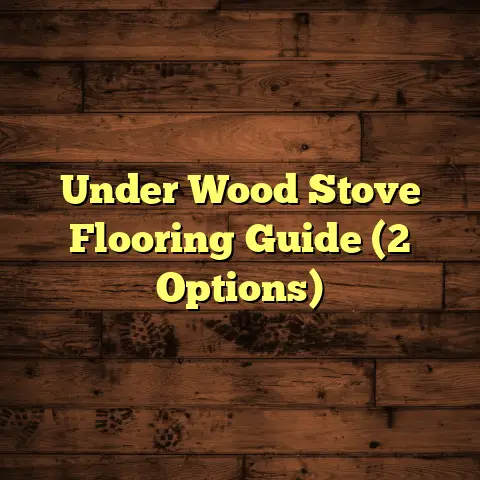Best Wood Tiles For Basements: Right Style & Material? (Explained)
When it comes to flooring options, versatility is key. I’ve seen firsthand how wood tiles can transform basements into inviting spaces. The combination of warmth and durability makes them a fantastic choice. But choosing the right style and material can be a journey filled with questions and discoveries.
My Journey with Wood Tiles
I remember my first basement project vividly. It was a sprawling space that had been neglected for years. The walls were cold, and the concrete floor felt unwelcoming. I decided to use wood tiles to create a cozy atmosphere, and that decision changed everything.
I started by exploring different wood tile options. Each type has its own unique character, which adds to the overall ambiance. For example, I found that engineered wood tiles worked beautifully in terms of moisture resistance while still offering the visual appeal of hardwood.
Choosing the Right Style
When selecting wood tiles, the style plays a crucial role. Do you prefer a rustic look or something more modern? I’ve tried various styles, from wide planks that create an open feel to narrower tiles that add texture.
I once installed a reclaimed wood tile in a client’s basement. The distinct knots and grains brought character to the room, making it feel warm and inviting. It’s amazing how the right style can completely change perceptions of a space.
Rustic vs. Modern
In my experience, rustic styles tend to resonate well with homeowners looking for a cozy, homey vibe. I recall one project where we installed distressed wood tiles in a farmhouse-style basement. The result was stunning; the warmth of the wood contrasted beautifully with the whitewashed walls.
On the other hand, modern styles often feature cleaner lines and lighter colors. During another project, we opted for sleek, gray-toned wood tiles that gave the basement a contemporary feel. The space transformed from dark and dreary to bright and chic.
Material Matters
Next up is material. The choice between solid hardwood, engineered wood, and laminate can be overwhelming. Each has its pros and cons based on the specific environment of a basement.
Engineered Wood
This has become my go-to for basements due to its stability. It’s manufactured to withstand fluctuations in temperature and humidity. I had a project where we installed engineered wood tiles over radiant heating, and it performed exceptionally well.
The construction of engineered wood involves several layers of material, typically a plywood base with a hardwood veneer on top. This design enhances durability and moisture resistance. In one installation, we used 7-inch wide engineered planks in a hickory finish, which not only looked stunning but also stood up well against potential moisture issues.
Solid Hardwood
While beautiful, solid hardwood is generally not recommended for basements due to moisture concerns. I learned this lesson the hard way when a client insisted on solid hardwood despite my warnings. After a few months, we had to replace several planks due to warping.
Solid hardwood can expand and contract with changes in humidity levels, which is problematic in below-grade spaces. If you’re set on using solid hardwood in your basement, make sure to implement proper climate control measures.
Laminate
Often seen as a budget-friendly option, laminate can mimic the look of wood tiles effectively. I’ve used it in areas where a tight budget was necessary, but it doesn’t have the same longevity or feel as natural wood.
One notable project involved laminate flooring in a rental property. The tenants loved the look of the laminate wood tiles, but after a year, we noticed some wear and tear. While it held up reasonably well under foot traffic, it lacked the warmth and depth of real wood.
Installation Insights
Installing wood tiles can be straightforward, but I’ve faced challenges along the way. One of my first basement installations involved uneven subflooring. It required additional preparation and leveling, which added time and costs. I learned that taking the time upfront to assess the subfloor can save headaches later.
Using FloorTally has streamlined my estimation process significantly. It allows me to input various factors, including material costs, labor rates, and even waste factors. This tool helps me outline accurate budgets for clients, ensuring they know what to expect from the start.
For instance, during one project, FloorTally helped me calculate the exact amount of tile needed, factoring in waste and cuts. This precise calculation resulted in minimal leftover materials, which is always a win for both me and my clients.
Preparing the Subfloor
Before laying any wood tiles, I always stress the importance of preparing the subfloor properly. A level surface is essential for achieving an even look when the tiles are installed. In one instance, I encountered a concrete subfloor that had several dips and rises. Instead of rushing through it, I took the time to level it out using self-leveling compound.
The end result was worth it; the installation went smoothly without any issues down the line. This taught me that investing time in preparation pays off in ensuring quality work.
Maintenance Tips
Once installed, maintaining wood tiles is crucial for longevity. Regular cleaning and proper humidity control can make a significant difference. I always recommend using soft brooms or vacuums specifically designed for hard floors to avoid scratching.
In one memorable case, a client neglected their wood tiles for months, leading to dullness and dirt buildup. After a thorough cleaning and applying specialized wood floor polish, we brought them back to life! It was rewarding to see their excitement when they realized how beautiful their flooring could look again.
Humidity Control
Humidity control is especially important in basements where moisture levels can fluctuate significantly. I advise clients to invest in dehumidifiers during humid months to prevent any potential damage to wood tiles.
During one particularly humid summer, I installed a dehumidifier in my own basement as an experiment. Not only did it help maintain optimal humidity levels, but it also kept my wood flooring looking pristine.
Practical Tips for Selection
- Consider Your Climate: If you live in an area with high humidity, engineered wood is your best bet.
- Think About Foot Traffic: For busy areas, choose harder finishes that can withstand wear.
- Get Samples: Always bring home samples before making a final decision. Natural light can change how colors appear.
- Consult Professionals: Don’t hesitate to ask your contractor for insights based on their experience with different materials.
- Keep Budget in Mind: While it’s tempting to go for high-end options, consider your overall budget including installation costs.
Challenges Faced
Throughout my career, I’ve encountered challenges that tested my skills. One notable project involved installing wood tiles in a basement that frequently flooded due to heavy rains. After some research, I decided on moisture-resistant engineered wood.
While the installation went smoothly, I had to return after several months for maintenance checks due to minor warping in some areas. This experience taught me the importance of client education regarding environmental factors that could affect their flooring choices.
Working with Clients
Sometimes clients have strong opinions about what they want, even if it may not be the best choice for their situation. In one case, a client insisted on using solid hardwood despite my reservations about moisture levels in their basement.
After several discussions about potential issues, we compromised by using engineered wood that mimicked solid hardwood closely while providing better moisture resistance. In hindsight, this was one of my wisest decisions as it saved both time and frustration later on.
Cost Considerations
Cost is always an important factor when planning any flooring project. I’ve learned that being transparent about costs from the beginning fosters trust with clients.
Using FloorTally helps streamline this process by providing detailed estimates based on local material prices and labor rates. During one project where we used high-end engineered wood tiles from a specialty retailer, FloorTally allowed me to generate an accurate budget quickly.
For example:
- Material Costs: Engineered wood tiles can range from $3 to $10 per square foot depending on the quality.
- Labor Costs: Installation labor typically runs between $2 to $5 per square foot.
- Additional Costs: Don’t forget about underlayment or moisture barriers if required; these can add another $1 per square foot.
When presenting this information to clients, I always break down costs into clear categories so they understand where their money is going.
Personal Anecdotes
Throughout my career as a flooring contractor, I’ve accumulated countless stories that highlight both successes and challenges I’ve faced working with wood tiles in basements.
One memorable project involved turning a dank cellar into a livable space for family gatherings. We chose rich mahogany-engineered tiles that added warmth without compromising on durability—perfect for managing potential humidity issues inherent in basements.
However, midway through installation, we discovered significant water damage along one wall from an unseen leak. This setback required immediate attention; we had to relocate some furniture temporarily while repairs were made before we could proceed with laying down our beautiful new floor.
Despite these challenges—and occasional frustrations—it was incredibly rewarding seeing how this transformation brought joy to my clients as they enjoyed their newly revamped space!
Conclusion
Choosing the best wood tiles for basements involves careful consideration of style, material, installation processes, and ongoing maintenance. Every project offers unique challenges and triumphs that contribute to your knowledge as a contractor.
Through my journey with wood tiles, I’ve learned to balance aesthetics with practicality while ensuring my clients are informed every step of the way. Whether you’re aiming for a cozy retreat or a functional workspace in your basement, the right wood tiles can make all the difference.
Do you have any specific projects you’re thinking about? Let’s chat about what styles or materials you’re considering!





